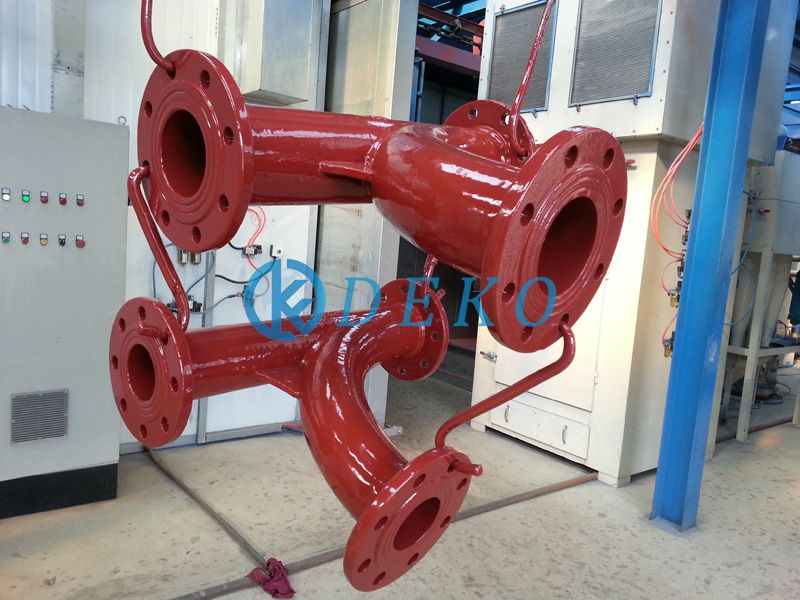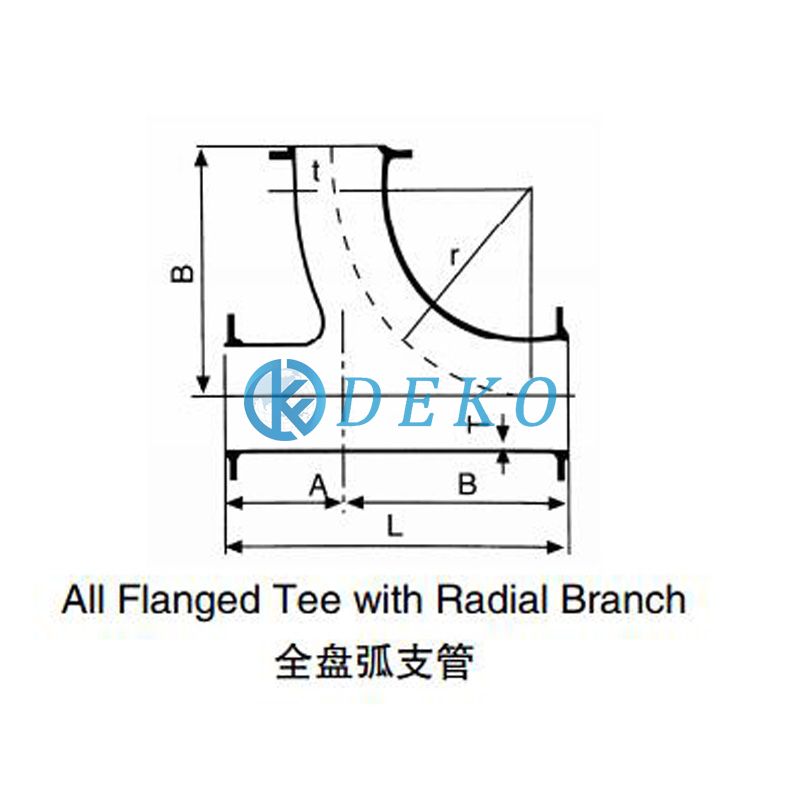A Guide to Mechanical Tees for Fire Sprinkler Systems
Mechanical tees help you retrofit and expand sprinkler systems
Tees are pipe fittings with three outlets—two in a line and a third 90 degrees between them. In fire sprinkler systems, a heavy main water line carries water through the building, and lighter branch lines distribute it to the sprinkler heads. Tees connect branch lines to the main lines and account for various changes in elevation and the direction of pipe and water.
When renovations or retrofits are necessary—such as for building additions or changes in code—new branch lines and tees may also be required. And even though grooved pipe couplings are made to come apart easily, disassembling an extensive sprinkler system to add standard tees can be a burdensome process. Mechanical tees make that task easier: Simply attach them to the existing pipe, drill a hole, and fasten a water-tight outlet to get new water and pipe direction.
How mechanical tees work
Mechanical tees, as part of grooved piping systems, use gaskets secured by housings to attach a new line of pipe to an existing one. The mechanical force from the bolts and nuts combined with the gasket and lubricant creates a tight seal around a hole drilled into a run of pipe. This eliminates the need to cut or disassemble pipe, potentially reducing man-hours and materials costs for something like the installation of a simple branch line.
The components of a mechanical tee
Mechanical tees have the same basic parts as grooved couplings—nuts and bolts, housings, and gaskets. In grooved couplings, the gasket fits around the circumference of the two butted pipes, and the housing holds them together end-to-end. Read our previous blog for more information on grooved piping systems. In mechanical tees, the gasket fits around the circumference of a hole drilled perpendicular (on center-line) to a pipe. The housing and its hardware secure the outlet to the drilled hole.
Mechanical tees have the following components:
An upper housing, which accepts the gasket and has an outlet
A lower housing, which secures the upper housing to the pipe
A gasket for creating a seal
Bolts and nuts
Some mechanical tees use a U-bolt instead of a lower housing. The U-bolt fits around the pipe in the same way the lower housing would. U-bolt mechanical tees can be good cost-saving alternatives.
Pipe size for fire sprinkler mechanical tees
The housing of a mechanical tee fits around the pipe that is receiving an outlet. The inner diameter of the housing matches the outer diameter of the pipe. Mechanical tees are sold based on the nominal pipe size (NPS) they fit. For instance, the housing of a 3” mechanical tee fits around a 3” nominal pipe. The housing’s inner diameter is 3.5 inches, the same as the pipe’s actual outer diameter.
Outlet size and type for mechanical tees
Mechanical tees create outlets that exit pipes, but the outlet is not necessarily the same size as the main pipe. Indeed, many mechanical tees are reduced, meaning that the branch pipe is smaller than the main pipe. Outlet size is also given in nominal pipe size, not actual size.
Note that outlet size, whether nominal or actual, does not correspond to the size of the hole drilled into the pipe. For instance, a 1.5-inch nominal outlet (whose actual outer diameter is 1.9 inches) needs a 2.7-inch hole. Manufacturer instructions will specify the size of the hole required.
Mechanical tee outlets accept different kinds of pipe, the two most common being grooved and threaded. Threaded outlets are female, and their size is given in Female National Pipe Thread (FNTP).
Materials, listing, and performance for fire sprinkler mechanical tees
Properly manufactured mechanical tees conform to several standards. Look for UL and FM markings when shopping for mechanical tees to know that the fittings are listed and approved. Like all pipe fittings, different tees have different performance limits. For one, mechanical tees can only withstand internal pressure up to a certain point—their maximum working pressure. The manufacturer will provide this value. Beyond this, also consider the housing material and the gasket material.
Featured content:Key Differences between Prestressing and Post-Tensioning
How much does CNC cost?
Is a post tension slab better?
What are the Limitations of Gabions?
Choosing the Right Pipe Clamp
How do you fix a sliding window that won't slide?
Housing materials
Commonly used for pipe and pipe fittings, ductile iron makes up the housing of many mechanical tees. Ductile iron offers high tensile strength and wear resistance and dissipates heat and vibration well. The ductile iron in a mechanical tee should conform to specifications from ASTM International; in particular, ASTM A536: Standard Specification for Ductile Iron Castings. Copper, steel (stainless and carbon), CPVC, and HPDE tees are also on the market.
Types of gaskets for mechanical tees
A synthetic rubber gasket creates a tight seal for a mechanical tee. Because different materials react differently to heat and various chemicals, the type of gasket used determines what the pipe can be used to transport. Three primary gasket materials are available: EPDM, nitrile, and silicone.
EPDM rubber works well in wet, hot (up to 230 °F/110 °C), and even acidic and salty conditions. This makes it perfect for fire sprinkler pipes. However, EPDM breaks down when exposed to nonpolar hydrocarbons, so it’s unsuitable for transporting petroleum products, hydrocarbon solvents, and aromatic compounds.
Nitrile rubber fills a different niche, tolerating water and heat only up to 150 °F or 65 °C but resisting nonpolar compounds. Nitrile is thus ideal for petroleum products, hydrocarbon solvents, transmission and hydraulic fluids, and more.
Silicone gaskets don’t resist petroleum and other hydrocarbons very well. But they have an exceptional range of temperature tolerances, remaining flexible at incredibly cold temperatures (anywhere from -76° to -148° F/-60° to -100 °C) and not breaking down even at extremely high temperatures (446° to 572° F/230° to 300° C). Silicone gaskets are common in food and medical applications.
Check out our selection of FM and UL-approved mechanical tees with ductile iron housings, 300 psi working pressures, and EPDM gaskets—perfect for fire sprinkler systems. Our fittings are sized for pipe ranging from 1 ¼ inch to 6 inches and feature groove or threaded outlets. U-bolt options are available.
Applications and installation of mechanical tees for sprinklers
Mechanical tees make retrofitting and remodeling easy because they save you the trouble of having to cut or disassemble a lot of pipes. Perhaps you need to put a new branch line to come off a fire sprinkler main. If you need the branch near the end of the run of pipe, undoing a few grooved couplings and adding a conventional tee should be easy enough. But if the branch needs to come off a central part of the network, you could have a lot of pipes to cut and move. And if you have soldered, welded, or another kind of connection instead of grooved, you could spend a lot of time and materials to disassemble and reassemble your sprinkler lines.
To install a mechanical tee:
Start by draining the pipes.
Then, locate the center line on the length of pipe that will receive the tee and mark the center of the news outlet.
Using an industrial hole-saw, drill a hole perpendicular to the center-line. Note that the hole size is not the same as the outlet pipe size. For instance, a tee with a 1 ½” nominal grooved outlet (1.9” actual outer diameter) requires a 2.007” hole per manufacturer instructions.
Once the hole is cut, prepare the pipe and tee for installation. Deburr the edges of the hole and clear away debris. Inspect the quality of the gasket and the pipe surface around the hole for anything that might impede a good seal—dirt, lumps on the pipe, tear in the gasket, etc.
With that done, lubricate the gasket according to manufacturer instructions. Assemble the housings around the pipe so that the outlet is over the hole and tighten the nuts. Under- or over-tightening, the bolts can damage the hardware or affect the performance. Tighten the nuts to the torque specified by the manufacturer using a torque wrench.
Different manufacturers give different guidance. For some systems, contact between the metal housings indicates sufficient torque. For others, this is not necessary. The 100Tong Handbook, for example, says that the outlet housing should make metal-to-metal contact with the pipe, but that gaps between the two housings are acceptable as long as they are symmetrical.
To round out your shopping list, check out our other grooved fittings, including standard tees, elbows, caps, drain caps, and grooved couplings.
1378
0
0
All Comments (0)
Previous: The Ultimate Guide to the Y-Strainer Valve
Next: Single VS. Double Loop Bale Ties - Which One Is Right for You?
If you are interested in sending in a Guest Blogger Submission,welcome to write for us!




Comments